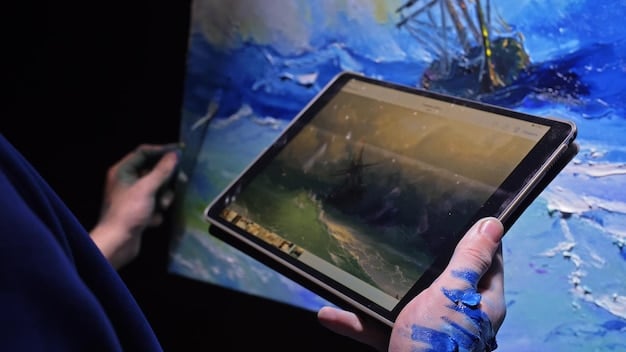The Rise of Virtual Art Galleries in the US: Expanding Art Access

The rise of virtual art galleries in the US is democratizing art access by allowing a wider audience to experience and engage with art from anywhere, transcending geographical limitations and traditional gallery constraints.
The art world is evolving, and one of the most exciting developments is the rise of virtual art galleries in the US: reaching a wider audience. These digital spaces are transforming how art is created, displayed, and experienced, offering unprecedented access and engagement for artists and art lovers alike.
The Evolution of Art Consumption
The way we consume art has changed drastically over the years. From exclusive viewings in elite galleries to accessible online platforms, art is becoming more democratic and inclusive. Virtual art galleries are at the forefront of this shift, offering a new paradigm for experiencing art.
The Shift to Digital Platforms
With the proliferation of the internet, digital platforms have become essential for art consumption. Online galleries and virtual exhibitions provide a convenient way for people to explore art from the comfort of their homes. This digital shift has opened doors for artists and audiences who may have previously been excluded from the traditional art world.
Democratizing Art Access
Virtual galleries play a crucial role in making art more accessible. By removing geographical barriers and reducing costs, they allow a broader audience to engage with art. This democratization empowers emerging artists and cultivates a more diverse and inclusive art community.
- Breaking down geographical barriers.
- Reducing the costs associated with traditional galleries.
- Empowering emerging artists.
- Cultivating a more diverse and inclusive art community.
Virtual art galleries are not just a trend; they represent a fundamental change in how art is consumed. They provide opportunities for both artists and audiences to connect in new and meaningful ways, fostering a more vibrant and dynamic art ecosystem. As technology continues to evolve, these digital spaces will likely play an even greater role in shaping the future of art.
Benefits for Artists and Collectors
Virtual art galleries offer a multitude of benefits for both artists and collectors. These digital spaces provide artists with new avenues for showcasing their work and connecting with potential buyers, while collectors gain access to a wider range of art from the comfort of their homes.
Expanded Reach and Exposure
One of the primary advantages of virtual galleries is their ability to reach a global audience. Artists can showcase their work to potential buyers and art enthusiasts from around the world, significantly expanding their reach and exposure. This international exposure can lead to new opportunities for sales and collaborations.
Cost-Effective Alternatives
Traditional art galleries often come with high overhead costs, including rent, staffing, and exhibition expenses. Virtual galleries offer a more cost-effective alternative, allowing artists to showcase their work without incurring these hefty expenses. This can be particularly beneficial for emerging artists who may not have the financial resources to exhibit in a traditional gallery.

Collectors also benefit from the cost-effectiveness of virtual galleries. They can browse and purchase art without having to travel to physical galleries, saving time and money. Additionally, virtual galleries often offer lower prices than traditional galleries, making art more accessible to a wider range of collectors.
The benefits of virtual art galleries extend beyond cost savings. They also provide opportunities for artists and collectors to connect in new and meaningful ways, fostering a more dynamic and collaborative art community. As these digital spaces continue to evolve, they will likely play an increasingly important role in shaping the future of the art market.
Overcoming Traditional Gallery Limitations
Traditional art galleries have long been the gatekeepers of the art world, but they come with inherent limitations. Virtual art galleries offer a way to overcome these limitations, providing a more inclusive and accessible platform for artists and art lovers alike.
Accessibility and Inclusivity
One of the key limitations of traditional galleries is their physical location. They are often concentrated in urban areas, making it difficult for people in rural or remote areas to access art. Virtual galleries eliminate this barrier, allowing anyone with an internet connection to explore and engage with art.
Breaking Down Geographical Barriers
Virtual galleries break down geographical barriers, enabling artists and collectors from different parts of the world to connect and collaborate. This global reach can lead to new opportunities for artists to showcase their work and for collectors to discover unique and diverse art.
Flexibility in Display and Curation
Virtual galleries offer greater flexibility in terms of display and curation. Artists can experiment with different layouts and themes, showcasing their work in creative and innovative ways. Collectors can also customize their virtual viewing experience, creating a personalized art journey.
- Enhanced accessibility for art enthusiasts in remote areas.
- Global reach for artists and collectors.
- Customizable viewing experiences.
- Innovative display options.
Virtual art galleries are not just a supplement to traditional galleries; they are a transformative force in the art world. By overcoming limitations and providing new opportunities, they are reshaping how art is experienced and appreciated.
Technological Innovations Driving Growth
Several technological innovations are driving the growth of virtual art galleries. These advancements are enhancing the viewing experience, making it more immersive and engaging for art enthusiasts.
Virtual Reality (VR) and Augmented Reality (AR)
VR and AR technologies are revolutionizing the way we experience art. VR allows users to step into a virtual gallery, exploring art in a fully immersive environment. AR, on the other hand, overlays digital art onto the real world, creating a unique and interactive viewing experience.
High-Resolution Imaging and 3D Modeling
High-resolution imaging and 3D modeling technologies enable artists to showcase their work in stunning detail. Viewers can zoom in on paintings to appreciate brushstrokes or rotate sculptures to examine them from all angles. This level of detail enhances the viewing experience and brings art to life in a digital format.

These technological innovations are not just about creating better visuals; they are about transforming the way we interact with art. By making art more accessible, engaging, and immersive, they are fostering a new generation of art lovers and collectors. As technology continues to advance, the possibilities for virtual art galleries are endless.
Challenges and Considerations
While virtual art galleries offer numerous benefits, they also come with certain challenges and considerations. Addressing these challenges is crucial for the continued growth and success of these digital spaces.
Authenticity and Valuation
One of the primary challenges is ensuring the authenticity and valuation of art in the virtual world. Collectors need to be confident that they are purchasing genuine artworks and that their investments are secure. This requires robust authentication and verification processes.
Digital Rights Management
Protecting the digital rights of artists is another important consideration. Virtual galleries need to implement effective digital rights management (DRM) systems to prevent unauthorized copying and distribution of artworks. This ensures that artists are properly compensated for their creations.
Building Trust and Credibility
Building trust and credibility is essential for attracting both artists and collectors to virtual galleries. This requires transparency in operations, clear communication, and a commitment to providing a high-quality experience. Galleries must also establish partnerships with reputable art institutions and experts to enhance their credibility.
Overcoming these challenges requires a collaborative effort from artists, collectors, gallery owners, and technology providers. By working together, they can create a virtual art ecosystem that is both secure and sustainable. As these challenges are addressed, virtual galleries will continue to thrive and play an increasingly important role in the art world.
Future Trends in Virtual Art Galleries
The future of virtual art galleries is bright, with several exciting trends on the horizon. These trends are poised to further transform the way we experience and engage with art in the digital age.
AI-Powered Art Curation
Artificial intelligence (AI) is set to play a significant role in art curation. AI algorithms can analyze vast amounts of data to identify emerging artists, predict market trends, and personalize the viewing experience for individual users. This can help collectors discover new art that aligns with their tastes and preferences.
Enhanced Social Interaction
Virtual galleries are becoming more social, with features such as virtual tours, live Q&A sessions with artists, and interactive discussions with other art enthusiasts. These social interactions enhance the sense of community and make the viewing experience more engaging and enjoyable.
Integration with Blockchain Technology
Blockchain technology is revolutionizing the art market by providing a secure and transparent way to track ownership and provenance. Virtual galleries are integrating blockchain to ensure the authenticity of artworks and to facilitate secure transactions. This can help build trust and confidence among collectors.
- Personalized art recommendations powered by AI.
- Interactive virtual tours and artist Q&A sessions.
- Secure art transactions using blockchain technology.
- Expanded accessibility through mobile devices and VR headsets.
These future trends promise to make virtual art galleries even more accessible, engaging, and immersive. As technology continues to evolve, these digital spaces will likely become an integral part of the art world, offering new opportunities for artists, collectors, and art lovers alike.
| Key Point | Brief Description |
|---|---|
| 🌍 Accessibility | Virtual galleries break down geographical barriers. |
| 🎨 Cost-Effective | Lower overhead for artists and affordable access for collectors. |
| 🚀 Tech Innovations | VR, AR, and AI enhance the viewing experience. |
| 🔒 Security | Blockchain ensures authenticity and secure transactions. |
Frequently Asked Questions
▼
A virtual art gallery is an online platform where art can be viewed and often purchased. It replicates the experience of a physical gallery without the geographical limitations.
▼
Virtual galleries provide artists with greater exposure, lower costs, and opportunities to connect with a global audience, expanding their reach and potential sales.
▼
Virtual Reality (VR), Augmented Reality (AR), and high-resolution imaging are common technologies used to enhance the viewing experience in virtual galleries.
▼
Yes, with the integration of blockchain technology, virtual galleries are becoming more secure, ensuring the authenticity and provenance of artworks for collectors.
▼
Future trends include AI-powered art curation, enhanced social interaction features, and the continued integration of blockchain to improve security and transparency.
Conclusion
The rise of virtual art galleries in the US represents a significant shift in how art is created, consumed, and valued. By overcoming traditional limitations and embracing technological innovations, these digital spaces are democratizing access to art and fostering a more inclusive and vibrant art community.





